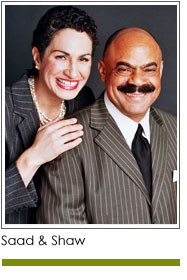 The board of directors of an organization is responsible for its financial health. What does this mean? How do you measure the fundraising health of the board? We at Saad&Shaw suggest a visit to the FUNdraising doctor. A check-up may be in order.
The board of directors of an organization is responsible for its financial health. What does this mean? How do you measure the fundraising health of the board? We at Saad&Shaw suggest a visit to the FUNdraising doctor. A check-up may be in order.
Below you will find symptoms of board health. Use these to evaluate the health of the boards you are involved with. Join with your fellow board members to evaluate how healthy you are as a group. If you need to improve your health, you can.
The following are symptoms of FUNdraising health
1. Board members represent a diverse cross section of individuals with power, wealth and influence. The participation of people who can make a difference in the financial health of your organization is critical.
2. The organization and its mission are a priority in the personal and professional lives of board members. Those who know you should know just how important board service is to you.
3. Board members, volunteers and staff work together from a fund development plan. Coordinating all fundraising activities allows your institution to secure the maximum yield on its fundraising efforts.
4. Board members make meaningful financial gifts. As a board member it is your responsibility to make a “stretch” gift each year. Your donation should be one of the largest that you and your family will make during the year. An organization cannot expect others to give if the leadership is unwilling to do so.
5. Board and staff evaluate their efforts and outcomes on an annual basis. Evaluation helps all members determine what impact they are making and how they can best contribute to the organization’s financial health.
6. Board members and volunteers use their contacts to secure meaningful gifts and to open doors. As a board member you can personally introduce new supporters to the institution and encourage their involvement.
7. The organization is included in the estate plans of board members and volunteers. As you plan for the financial future of your family members, consider also including a gift to benefit the organizations you serve.
8. Board members are accessible and involved. Don’t just sit on a board – get involved. Give of your time, attend meetings and engage others.
9. Members recruit new board members who are equally or more influential. It is up to you to ensure that future board members can provide the leadership and funding required for the fulfillment of your mission.
Discuss these health indicators with your fellow board members. How would you assess your fundraising health? What do you want to focus on in the coming year? Change is possible. There are many resources available to help you “get in shape” including articles and publications available on our website – www.saadandshaw.com.
Part two of this series will identify those symptoms of “compromised” health.
Copyright 2016 – Mel and Pearl Shaw
This column is an excerpt from FUNdraising Good Times Classics available on Amazon.com (http://bit.ly/SaadShawBooks) . For help growing your fundraising visit www.saadandshaw.com or call (901) 522-8727.
Part One of a Two Part Series











